Essay on Cognitive and Personality Development in Child Psychology
VerifiedAdded on 2022/09/24
|7
|1974
|150
Essay
AI Summary
This essay delves into the multifaceted realm of child development, examining both cognitive and personality growth through the lens of established psychological theories. The author uses the case of an eight-year-old niece to illustrate the practical application of Jean Piaget's stages of cognitive development, including sensorimotor and preoperational phases, while also incorporating the perspectives of Lev Vygotsky on social and language development, and Skinner's behaviorist approach to language acquisition. The essay further explores personality development, drawing upon Freud's theory of the unconscious mind and the trait theory of Eysenck, alongside Erikson's psychosocial stages. Through these frameworks, the essay provides a comprehensive overview of the factors influencing a child's intellectual, emotional, and social development, emphasizing the interplay of nature and nurture in shaping a child's growth. The analysis highlights the importance of understanding these theories for fostering positive child development and provides a relatable perspective on the different life cycles of a child.
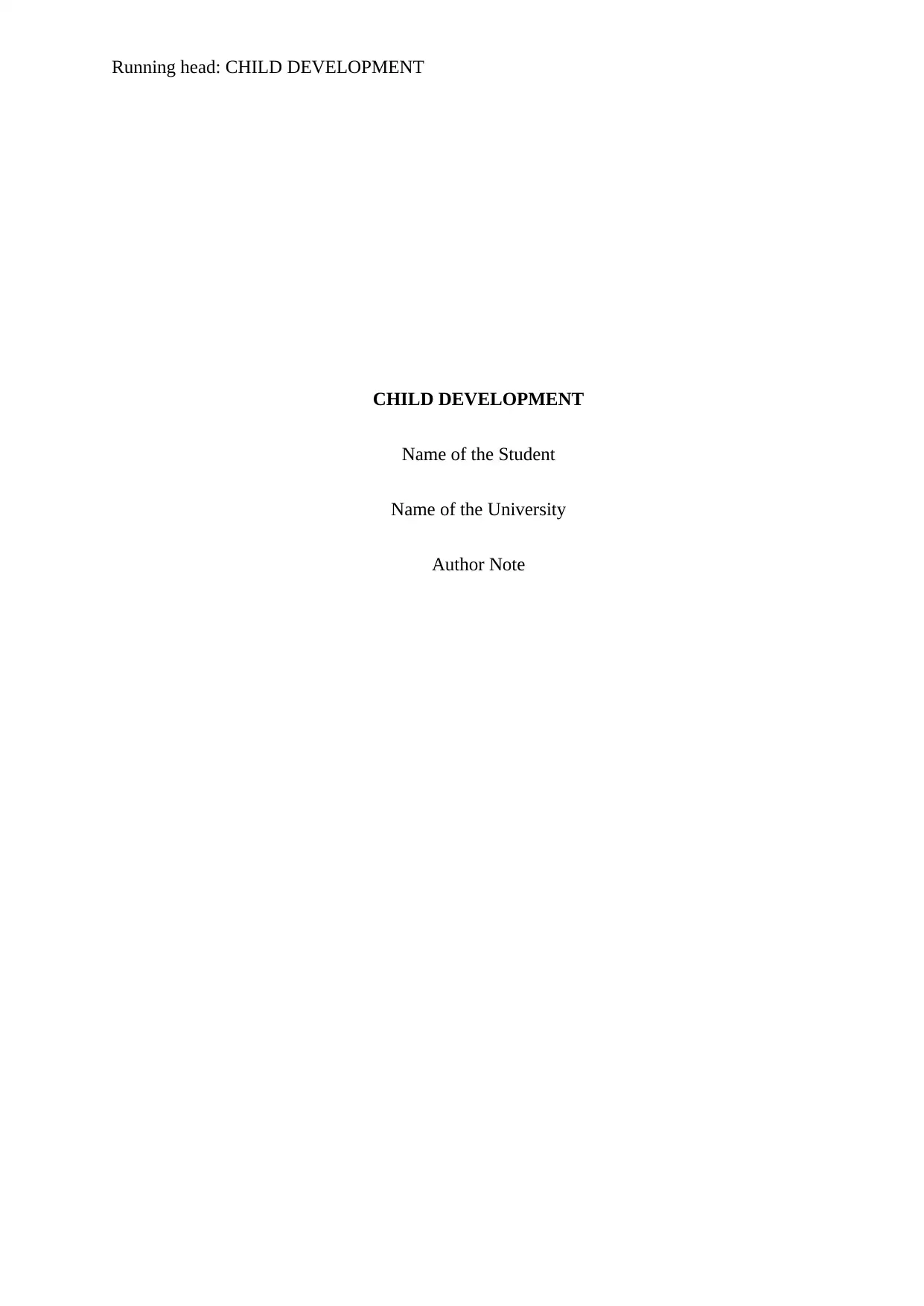
Running head: CHILD DEVELOPMENT
CHILD DEVELOPMENT
Name of the Student
Name of the University
Author Note
CHILD DEVELOPMENT
Name of the Student
Name of the University
Author Note
Paraphrase This Document
Need a fresh take? Get an instant paraphrase of this document with our AI Paraphraser
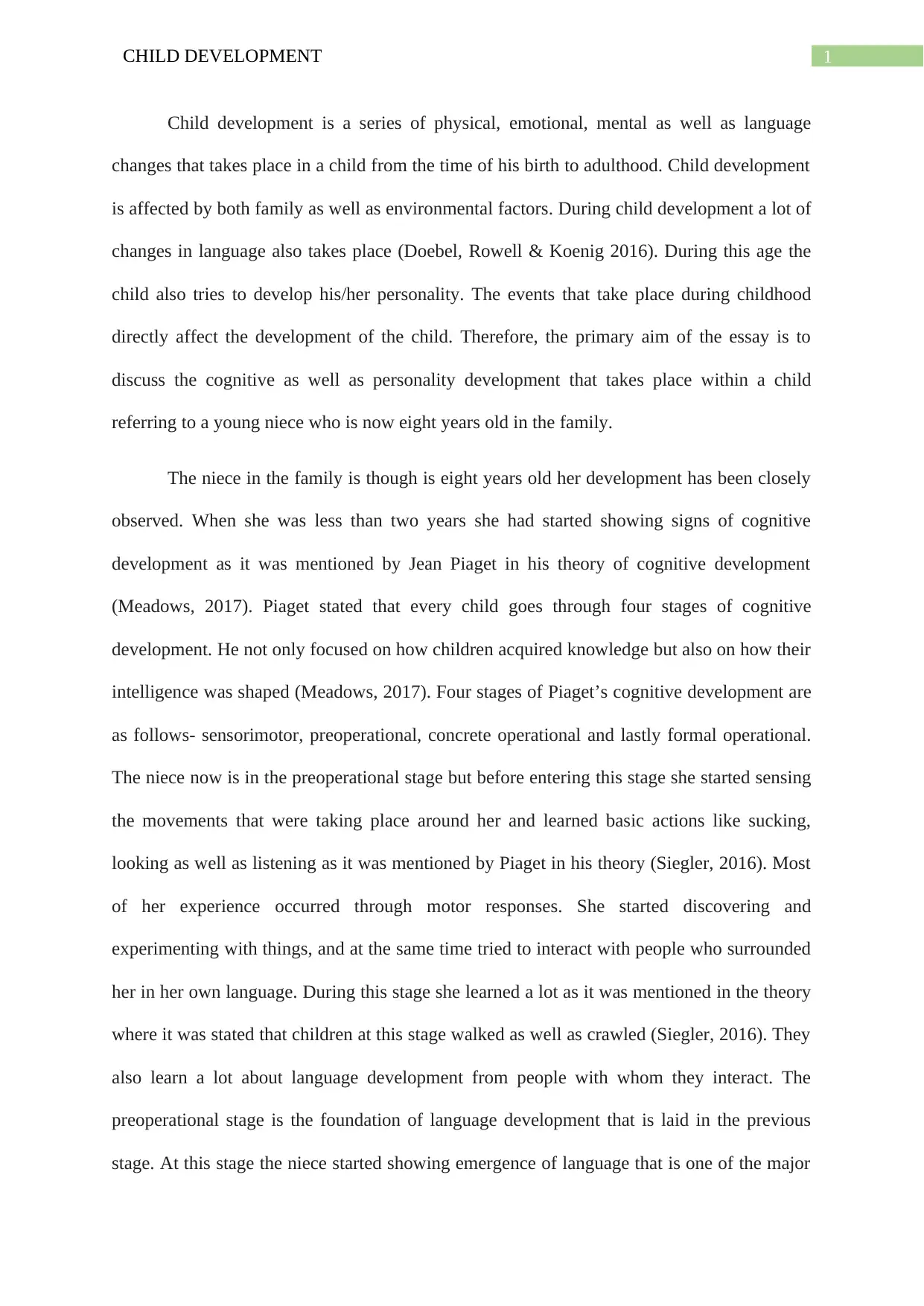
1CHILD DEVELOPMENT
Child development is a series of physical, emotional, mental as well as language
changes that takes place in a child from the time of his birth to adulthood. Child development
is affected by both family as well as environmental factors. During child development a lot of
changes in language also takes place (Doebel, Rowell & Koenig 2016). During this age the
child also tries to develop his/her personality. The events that take place during childhood
directly affect the development of the child. Therefore, the primary aim of the essay is to
discuss the cognitive as well as personality development that takes place within a child
referring to a young niece who is now eight years old in the family.
The niece in the family is though is eight years old her development has been closely
observed. When she was less than two years she had started showing signs of cognitive
development as it was mentioned by Jean Piaget in his theory of cognitive development
(Meadows, 2017). Piaget stated that every child goes through four stages of cognitive
development. He not only focused on how children acquired knowledge but also on how their
intelligence was shaped (Meadows, 2017). Four stages of Piaget’s cognitive development are
as follows- sensorimotor, preoperational, concrete operational and lastly formal operational.
The niece now is in the preoperational stage but before entering this stage she started sensing
the movements that were taking place around her and learned basic actions like sucking,
looking as well as listening as it was mentioned by Piaget in his theory (Siegler, 2016). Most
of her experience occurred through motor responses. She started discovering and
experimenting with things, and at the same time tried to interact with people who surrounded
her in her own language. During this stage she learned a lot as it was mentioned in the theory
where it was stated that children at this stage walked as well as crawled (Siegler, 2016). They
also learn a lot about language development from people with whom they interact. The
preoperational stage is the foundation of language development that is laid in the previous
stage. At this stage the niece started showing emergence of language that is one of the major
Child development is a series of physical, emotional, mental as well as language
changes that takes place in a child from the time of his birth to adulthood. Child development
is affected by both family as well as environmental factors. During child development a lot of
changes in language also takes place (Doebel, Rowell & Koenig 2016). During this age the
child also tries to develop his/her personality. The events that take place during childhood
directly affect the development of the child. Therefore, the primary aim of the essay is to
discuss the cognitive as well as personality development that takes place within a child
referring to a young niece who is now eight years old in the family.
The niece in the family is though is eight years old her development has been closely
observed. When she was less than two years she had started showing signs of cognitive
development as it was mentioned by Jean Piaget in his theory of cognitive development
(Meadows, 2017). Piaget stated that every child goes through four stages of cognitive
development. He not only focused on how children acquired knowledge but also on how their
intelligence was shaped (Meadows, 2017). Four stages of Piaget’s cognitive development are
as follows- sensorimotor, preoperational, concrete operational and lastly formal operational.
The niece now is in the preoperational stage but before entering this stage she started sensing
the movements that were taking place around her and learned basic actions like sucking,
looking as well as listening as it was mentioned by Piaget in his theory (Siegler, 2016). Most
of her experience occurred through motor responses. She started discovering and
experimenting with things, and at the same time tried to interact with people who surrounded
her in her own language. During this stage she learned a lot as it was mentioned in the theory
where it was stated that children at this stage walked as well as crawled (Siegler, 2016). They
also learn a lot about language development from people with whom they interact. The
preoperational stage is the foundation of language development that is laid in the previous
stage. At this stage the niece started showing emergence of language that is one of the major
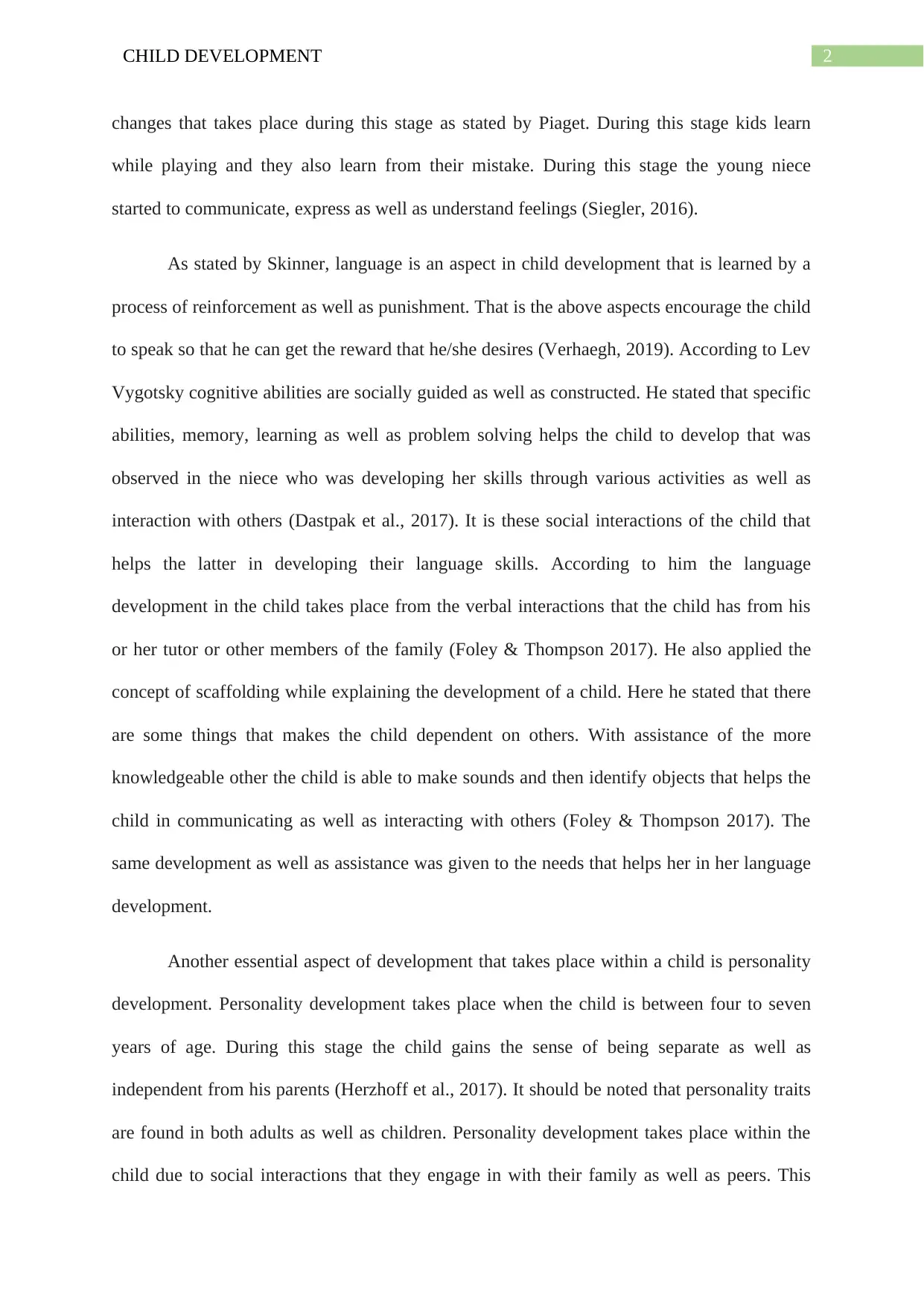
2CHILD DEVELOPMENT
changes that takes place during this stage as stated by Piaget. During this stage kids learn
while playing and they also learn from their mistake. During this stage the young niece
started to communicate, express as well as understand feelings (Siegler, 2016).
As stated by Skinner, language is an aspect in child development that is learned by a
process of reinforcement as well as punishment. That is the above aspects encourage the child
to speak so that he can get the reward that he/she desires (Verhaegh, 2019). According to Lev
Vygotsky cognitive abilities are socially guided as well as constructed. He stated that specific
abilities, memory, learning as well as problem solving helps the child to develop that was
observed in the niece who was developing her skills through various activities as well as
interaction with others (Dastpak et al., 2017). It is these social interactions of the child that
helps the latter in developing their language skills. According to him the language
development in the child takes place from the verbal interactions that the child has from his
or her tutor or other members of the family (Foley & Thompson 2017). He also applied the
concept of scaffolding while explaining the development of a child. Here he stated that there
are some things that makes the child dependent on others. With assistance of the more
knowledgeable other the child is able to make sounds and then identify objects that helps the
child in communicating as well as interacting with others (Foley & Thompson 2017). The
same development as well as assistance was given to the needs that helps her in her language
development.
Another essential aspect of development that takes place within a child is personality
development. Personality development takes place when the child is between four to seven
years of age. During this stage the child gains the sense of being separate as well as
independent from his parents (Herzhoff et al., 2017). It should be noted that personality traits
are found in both adults as well as children. Personality development takes place within the
child due to social interactions that they engage in with their family as well as peers. This
changes that takes place during this stage as stated by Piaget. During this stage kids learn
while playing and they also learn from their mistake. During this stage the young niece
started to communicate, express as well as understand feelings (Siegler, 2016).
As stated by Skinner, language is an aspect in child development that is learned by a
process of reinforcement as well as punishment. That is the above aspects encourage the child
to speak so that he can get the reward that he/she desires (Verhaegh, 2019). According to Lev
Vygotsky cognitive abilities are socially guided as well as constructed. He stated that specific
abilities, memory, learning as well as problem solving helps the child to develop that was
observed in the niece who was developing her skills through various activities as well as
interaction with others (Dastpak et al., 2017). It is these social interactions of the child that
helps the latter in developing their language skills. According to him the language
development in the child takes place from the verbal interactions that the child has from his
or her tutor or other members of the family (Foley & Thompson 2017). He also applied the
concept of scaffolding while explaining the development of a child. Here he stated that there
are some things that makes the child dependent on others. With assistance of the more
knowledgeable other the child is able to make sounds and then identify objects that helps the
child in communicating as well as interacting with others (Foley & Thompson 2017). The
same development as well as assistance was given to the needs that helps her in her language
development.
Another essential aspect of development that takes place within a child is personality
development. Personality development takes place when the child is between four to seven
years of age. During this stage the child gains the sense of being separate as well as
independent from his parents (Herzhoff et al., 2017). It should be noted that personality traits
are found in both adults as well as children. Personality development takes place within the
child due to social interactions that they engage in with their family as well as peers. This
⊘ This is a preview!⊘
Do you want full access?
Subscribe today to unlock all pages.

Trusted by 1+ million students worldwide
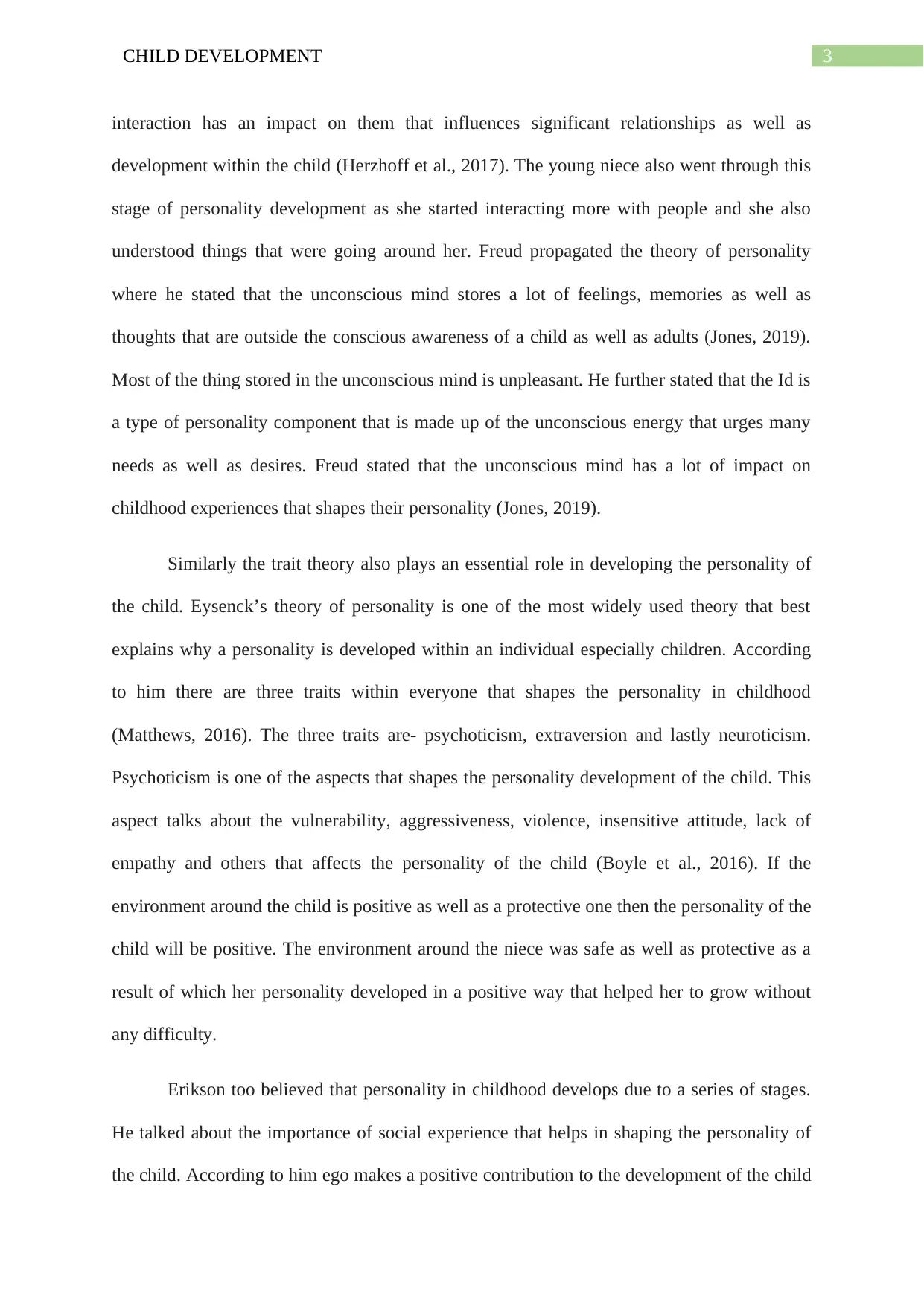
3CHILD DEVELOPMENT
interaction has an impact on them that influences significant relationships as well as
development within the child (Herzhoff et al., 2017). The young niece also went through this
stage of personality development as she started interacting more with people and she also
understood things that were going around her. Freud propagated the theory of personality
where he stated that the unconscious mind stores a lot of feelings, memories as well as
thoughts that are outside the conscious awareness of a child as well as adults (Jones, 2019).
Most of the thing stored in the unconscious mind is unpleasant. He further stated that the Id is
a type of personality component that is made up of the unconscious energy that urges many
needs as well as desires. Freud stated that the unconscious mind has a lot of impact on
childhood experiences that shapes their personality (Jones, 2019).
Similarly the trait theory also plays an essential role in developing the personality of
the child. Eysenck’s theory of personality is one of the most widely used theory that best
explains why a personality is developed within an individual especially children. According
to him there are three traits within everyone that shapes the personality in childhood
(Matthews, 2016). The three traits are- psychoticism, extraversion and lastly neuroticism.
Psychoticism is one of the aspects that shapes the personality development of the child. This
aspect talks about the vulnerability, aggressiveness, violence, insensitive attitude, lack of
empathy and others that affects the personality of the child (Boyle et al., 2016). If the
environment around the child is positive as well as a protective one then the personality of the
child will be positive. The environment around the niece was safe as well as protective as a
result of which her personality developed in a positive way that helped her to grow without
any difficulty.
Erikson too believed that personality in childhood develops due to a series of stages.
He talked about the importance of social experience that helps in shaping the personality of
the child. According to him ego makes a positive contribution to the development of the child
interaction has an impact on them that influences significant relationships as well as
development within the child (Herzhoff et al., 2017). The young niece also went through this
stage of personality development as she started interacting more with people and she also
understood things that were going around her. Freud propagated the theory of personality
where he stated that the unconscious mind stores a lot of feelings, memories as well as
thoughts that are outside the conscious awareness of a child as well as adults (Jones, 2019).
Most of the thing stored in the unconscious mind is unpleasant. He further stated that the Id is
a type of personality component that is made up of the unconscious energy that urges many
needs as well as desires. Freud stated that the unconscious mind has a lot of impact on
childhood experiences that shapes their personality (Jones, 2019).
Similarly the trait theory also plays an essential role in developing the personality of
the child. Eysenck’s theory of personality is one of the most widely used theory that best
explains why a personality is developed within an individual especially children. According
to him there are three traits within everyone that shapes the personality in childhood
(Matthews, 2016). The three traits are- psychoticism, extraversion and lastly neuroticism.
Psychoticism is one of the aspects that shapes the personality development of the child. This
aspect talks about the vulnerability, aggressiveness, violence, insensitive attitude, lack of
empathy and others that affects the personality of the child (Boyle et al., 2016). If the
environment around the child is positive as well as a protective one then the personality of the
child will be positive. The environment around the niece was safe as well as protective as a
result of which her personality developed in a positive way that helped her to grow without
any difficulty.
Erikson too believed that personality in childhood develops due to a series of stages.
He talked about the importance of social experience that helps in shaping the personality of
the child. According to him ego makes a positive contribution to the development of the child
Paraphrase This Document
Need a fresh take? Get an instant paraphrase of this document with our AI Paraphraser
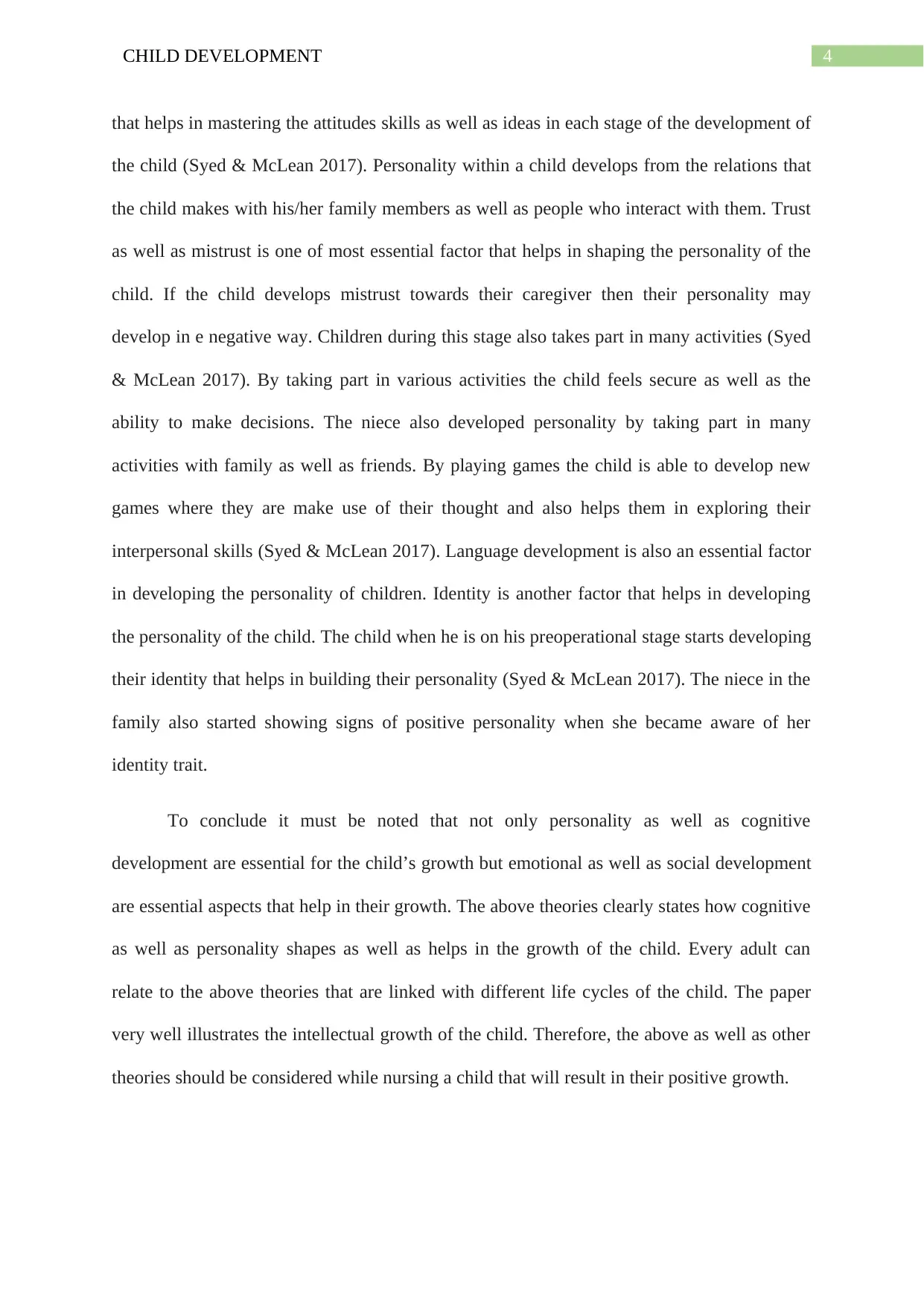
4CHILD DEVELOPMENT
that helps in mastering the attitudes skills as well as ideas in each stage of the development of
the child (Syed & McLean 2017). Personality within a child develops from the relations that
the child makes with his/her family members as well as people who interact with them. Trust
as well as mistrust is one of most essential factor that helps in shaping the personality of the
child. If the child develops mistrust towards their caregiver then their personality may
develop in e negative way. Children during this stage also takes part in many activities (Syed
& McLean 2017). By taking part in various activities the child feels secure as well as the
ability to make decisions. The niece also developed personality by taking part in many
activities with family as well as friends. By playing games the child is able to develop new
games where they are make use of their thought and also helps them in exploring their
interpersonal skills (Syed & McLean 2017). Language development is also an essential factor
in developing the personality of children. Identity is another factor that helps in developing
the personality of the child. The child when he is on his preoperational stage starts developing
their identity that helps in building their personality (Syed & McLean 2017). The niece in the
family also started showing signs of positive personality when she became aware of her
identity trait.
To conclude it must be noted that not only personality as well as cognitive
development are essential for the child’s growth but emotional as well as social development
are essential aspects that help in their growth. The above theories clearly states how cognitive
as well as personality shapes as well as helps in the growth of the child. Every adult can
relate to the above theories that are linked with different life cycles of the child. The paper
very well illustrates the intellectual growth of the child. Therefore, the above as well as other
theories should be considered while nursing a child that will result in their positive growth.
that helps in mastering the attitudes skills as well as ideas in each stage of the development of
the child (Syed & McLean 2017). Personality within a child develops from the relations that
the child makes with his/her family members as well as people who interact with them. Trust
as well as mistrust is one of most essential factor that helps in shaping the personality of the
child. If the child develops mistrust towards their caregiver then their personality may
develop in e negative way. Children during this stage also takes part in many activities (Syed
& McLean 2017). By taking part in various activities the child feels secure as well as the
ability to make decisions. The niece also developed personality by taking part in many
activities with family as well as friends. By playing games the child is able to develop new
games where they are make use of their thought and also helps them in exploring their
interpersonal skills (Syed & McLean 2017). Language development is also an essential factor
in developing the personality of children. Identity is another factor that helps in developing
the personality of the child. The child when he is on his preoperational stage starts developing
their identity that helps in building their personality (Syed & McLean 2017). The niece in the
family also started showing signs of positive personality when she became aware of her
identity trait.
To conclude it must be noted that not only personality as well as cognitive
development are essential for the child’s growth but emotional as well as social development
are essential aspects that help in their growth. The above theories clearly states how cognitive
as well as personality shapes as well as helps in the growth of the child. Every adult can
relate to the above theories that are linked with different life cycles of the child. The paper
very well illustrates the intellectual growth of the child. Therefore, the above as well as other
theories should be considered while nursing a child that will result in their positive growth.
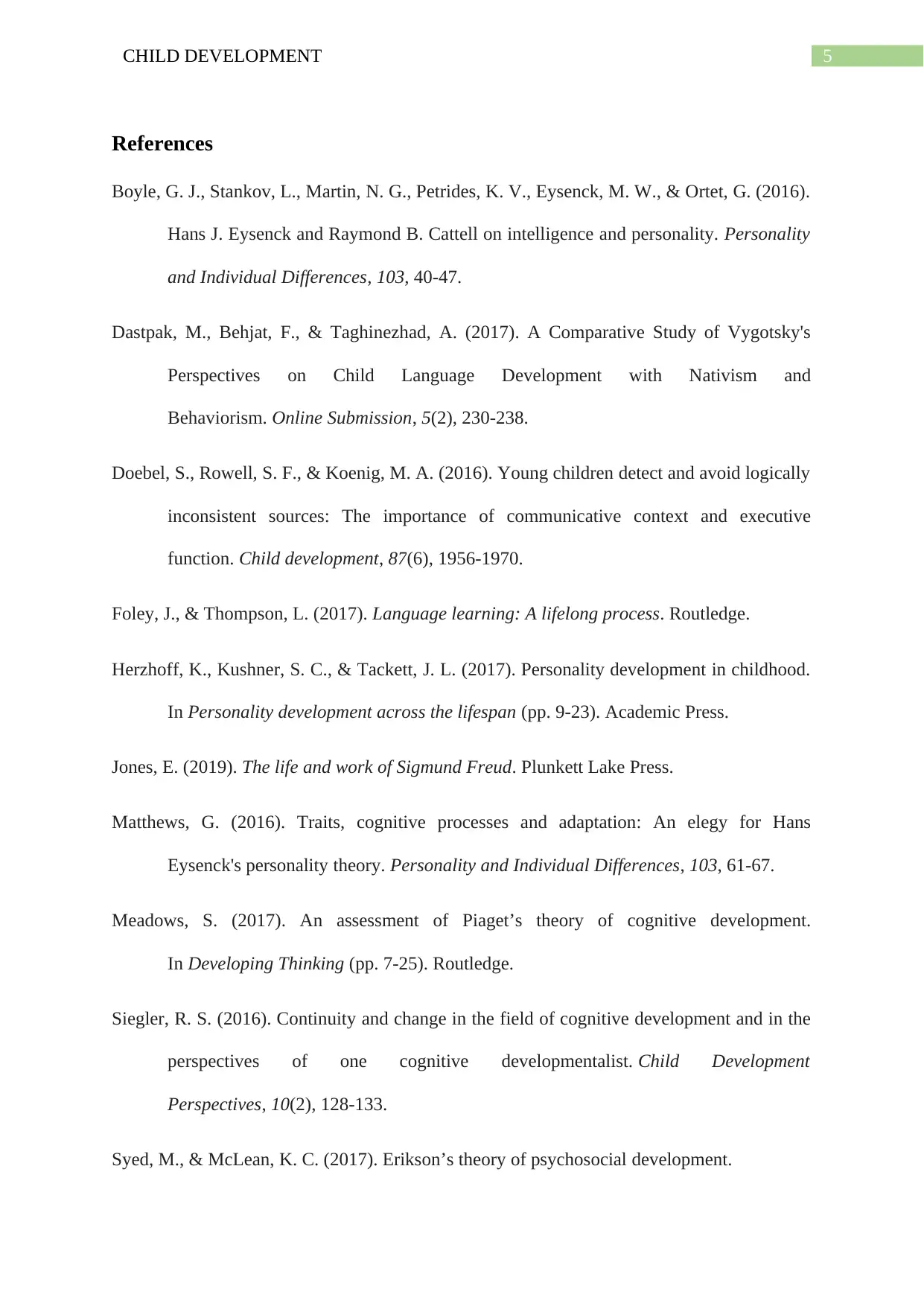
5CHILD DEVELOPMENT
References
Boyle, G. J., Stankov, L., Martin, N. G., Petrides, K. V., Eysenck, M. W., & Ortet, G. (2016).
Hans J. Eysenck and Raymond B. Cattell on intelligence and personality. Personality
and Individual Differences, 103, 40-47.
Dastpak, M., Behjat, F., & Taghinezhad, A. (2017). A Comparative Study of Vygotsky's
Perspectives on Child Language Development with Nativism and
Behaviorism. Online Submission, 5(2), 230-238.
Doebel, S., Rowell, S. F., & Koenig, M. A. (2016). Young children detect and avoid logically
inconsistent sources: The importance of communicative context and executive
function. Child development, 87(6), 1956-1970.
Foley, J., & Thompson, L. (2017). Language learning: A lifelong process. Routledge.
Herzhoff, K., Kushner, S. C., & Tackett, J. L. (2017). Personality development in childhood.
In Personality development across the lifespan (pp. 9-23). Academic Press.
Jones, E. (2019). The life and work of Sigmund Freud. Plunkett Lake Press.
Matthews, G. (2016). Traits, cognitive processes and adaptation: An elegy for Hans
Eysenck's personality theory. Personality and Individual Differences, 103, 61-67.
Meadows, S. (2017). An assessment of Piaget’s theory of cognitive development.
In Developing Thinking (pp. 7-25). Routledge.
Siegler, R. S. (2016). Continuity and change in the field of cognitive development and in the
perspectives of one cognitive developmentalist. Child Development
Perspectives, 10(2), 128-133.
Syed, M., & McLean, K. C. (2017). Erikson’s theory of psychosocial development.
References
Boyle, G. J., Stankov, L., Martin, N. G., Petrides, K. V., Eysenck, M. W., & Ortet, G. (2016).
Hans J. Eysenck and Raymond B. Cattell on intelligence and personality. Personality
and Individual Differences, 103, 40-47.
Dastpak, M., Behjat, F., & Taghinezhad, A. (2017). A Comparative Study of Vygotsky's
Perspectives on Child Language Development with Nativism and
Behaviorism. Online Submission, 5(2), 230-238.
Doebel, S., Rowell, S. F., & Koenig, M. A. (2016). Young children detect and avoid logically
inconsistent sources: The importance of communicative context and executive
function. Child development, 87(6), 1956-1970.
Foley, J., & Thompson, L. (2017). Language learning: A lifelong process. Routledge.
Herzhoff, K., Kushner, S. C., & Tackett, J. L. (2017). Personality development in childhood.
In Personality development across the lifespan (pp. 9-23). Academic Press.
Jones, E. (2019). The life and work of Sigmund Freud. Plunkett Lake Press.
Matthews, G. (2016). Traits, cognitive processes and adaptation: An elegy for Hans
Eysenck's personality theory. Personality and Individual Differences, 103, 61-67.
Meadows, S. (2017). An assessment of Piaget’s theory of cognitive development.
In Developing Thinking (pp. 7-25). Routledge.
Siegler, R. S. (2016). Continuity and change in the field of cognitive development and in the
perspectives of one cognitive developmentalist. Child Development
Perspectives, 10(2), 128-133.
Syed, M., & McLean, K. C. (2017). Erikson’s theory of psychosocial development.
⊘ This is a preview!⊘
Do you want full access?
Subscribe today to unlock all pages.

Trusted by 1+ million students worldwide
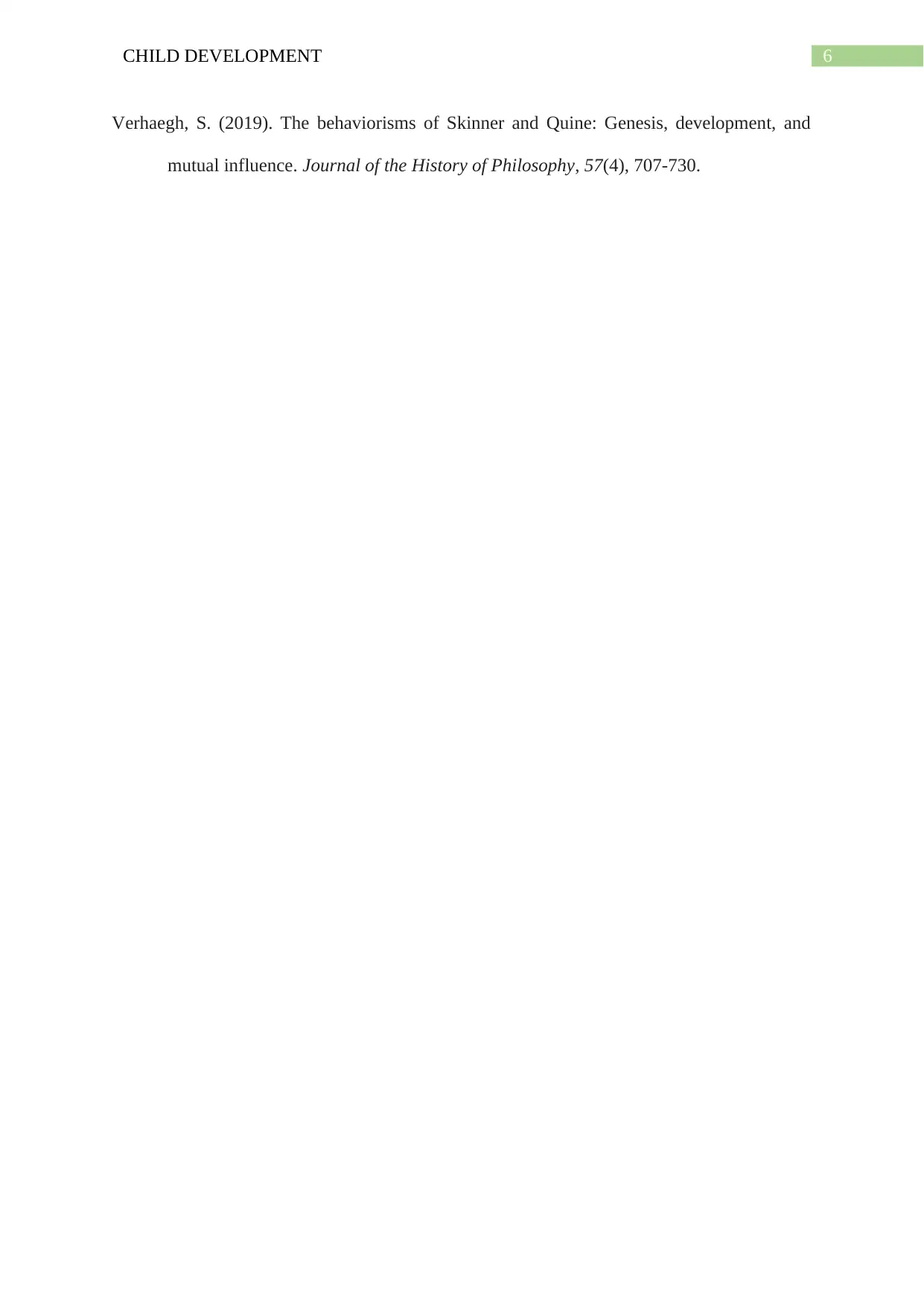
6CHILD DEVELOPMENT
Verhaegh, S. (2019). The behaviorisms of Skinner and Quine: Genesis, development, and
mutual influence. Journal of the History of Philosophy, 57(4), 707-730.
Verhaegh, S. (2019). The behaviorisms of Skinner and Quine: Genesis, development, and
mutual influence. Journal of the History of Philosophy, 57(4), 707-730.
1 out of 7
Related Documents
Your All-in-One AI-Powered Toolkit for Academic Success.
+13062052269
info@desklib.com
Available 24*7 on WhatsApp / Email
![[object Object]](/_next/static/media/star-bottom.7253800d.svg)
Unlock your academic potential
Copyright © 2020–2025 A2Z Services. All Rights Reserved. Developed and managed by ZUCOL.





